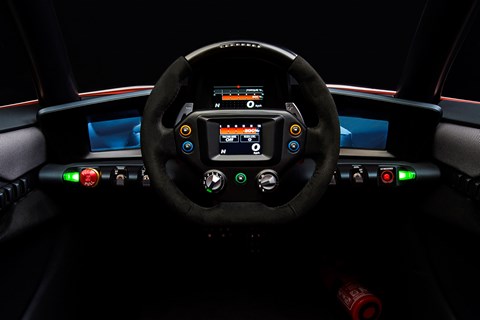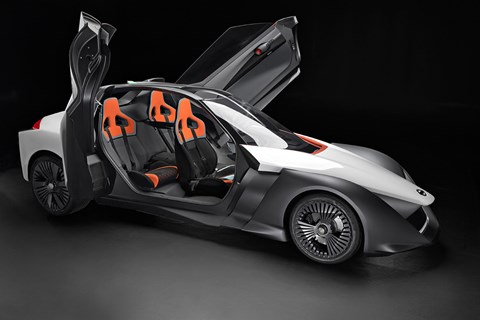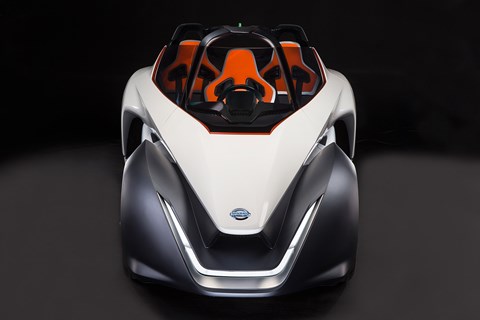► Nissan unveils new BladeGlider prototype
► Development of 2013 Tokyo show concept
► Capable of 0-62mph in less than 5sec
As the rest of the world gears up for the Rio 2016 Olympic Games, Nissan has been busy mating the all-electric Leaf to its ZEOD RC Le Mans racer. The result? A working prototype of the Nissan BladeGlider, an all-electric sport car.
The BladeGlider, which was unveiled in Brazil ahead of the Olympic opening ceremony, attempts to further blur the perceived disparity between alternatively powered cars and driving pleasure. It’s a development of the same-named concept that first shown at the 2013 Tokyo Auto Show – and Nissan is calling it ‘high performance in a revolutionary sports car design.’
How high is ‘high performance’?
The prototype is meant to demonstrate the future technologies expected in the sports car market. Energy is stored by a five-module 220kW lithium-ion battery. Power is transmitted to the tarmac through the rear wheels, which are driven individually by 130kW electric motors. The BladeGlider should be capable of 0-62mph in less than 5 seconds, reputedly, and run on to a top speed in excess of 118mph.

Nissan has developed the BladeGlider in partnership with Renault, which won back-to-back Formula E constructors championships and returned to Formula One as a factory team, and Williams Advanced Engineering – which added further to the wealth of F1 and Formula E experience.
For motorsport fans the familiarity doesn’t end there. Cast your mind back to 2013 and you may remember the messy divorce between the team behind the pioneering DeltaWing and Nissan’s ZEOD RC – but that hasn’t stopped Nissan from taking inspiration from much of the DeltaWing’s design ethos.
The prototype features a a narrow front track and tapered front end, which flows rearwards into strongly defined hips. The aim of the design is to massively increase the efficiency of the airflow, by cutting drag, in the aid of boosting performance and handling.
Is it as funky inside as it is outside?
The interior cherry-picks from some of motorsport’s finest creations. The three-seater layout with the passenger seats outboard of a central driving position is instantly relatable to the McLaren F1. Wheel-mounted displays show the state of charge, level of regenerative braking and traction control setting. The latter gives further signalling of Nissan’s driver focus for the car.

The BladeGlider packs a torque-vectoring system to eliminate mid-corner understeer. Setup options for this include an ‘Agile’ setting, presumably for optimal handling, and even a Ford Focus RS-inspired ‘Drift’ mode – which will no doubt do wonders for the range of this electric sports car. Either side of the wheel are screens that relay the video feed of two rear-view cameras, which replace the conventional door mirrors in an effort to make the BlideGlider as slippery as possible.
What’s the official line on it?
Nissan and Renault CEO Carlos Ghosn said: ‘These prototypes epitomise Nissan’s drive to expand its Intelligent Mobility philosophy, where driving pleasure combines with environmental responsibility. Nissan believes that enthusiasts should look forward to a zero emission future and BladeGlider is a perfect demonstration of that. It’s the electric vehicle for car-lovers.’

Those enthusiasts are treated to a panoramic windscreen that ensures the driver’s view is unhindered while also giving the impression of an open-cockpit LMP derivative. The rest of the styling is just as busy. Tones of BMW’s i8 are definitely present in the rear design, and that narrow nose and three-seat layout looks akin to the 3-seat dragster you find doing demo runs at Santa Pod.
The BladeGlider is meant show off what form next-generation sports cars may take. The paradox of fitting autonomous driving systems to the prototype would seem to negate much of the work Nissan has put into the car in order to make it handle as precisely as claimed – but for giving ‘dynamic rides’ to the VIPs at the Maracanã Stadium in Rio, it is all about the showcase.
Read CAR magazine’s Nissan reviews here
